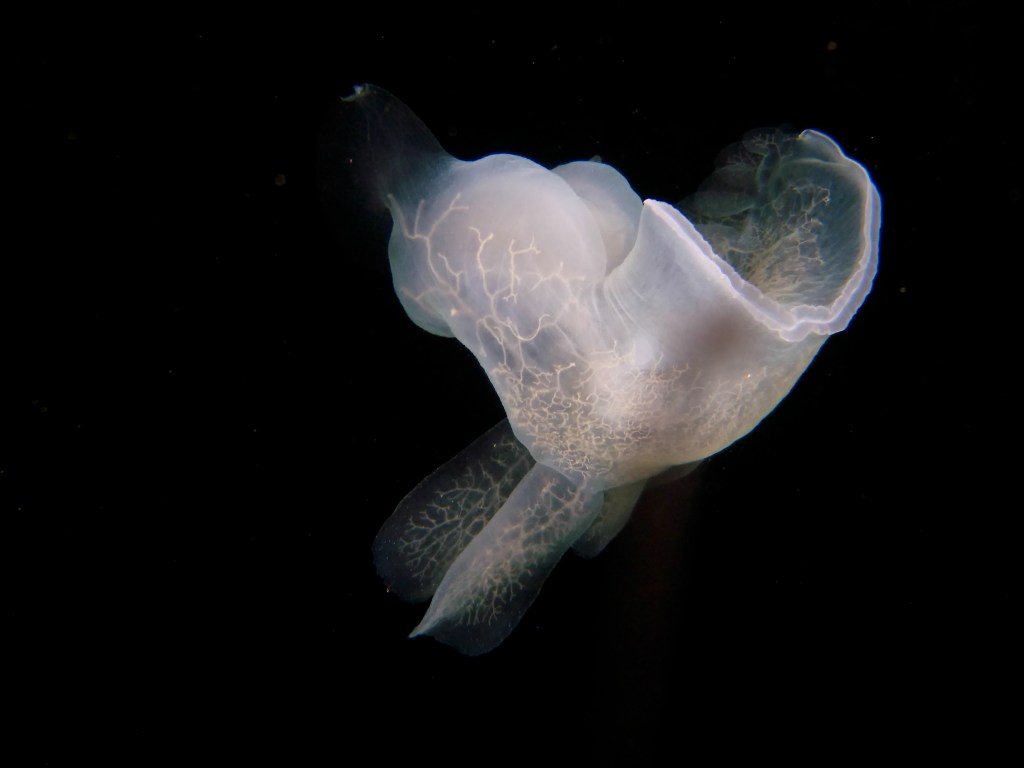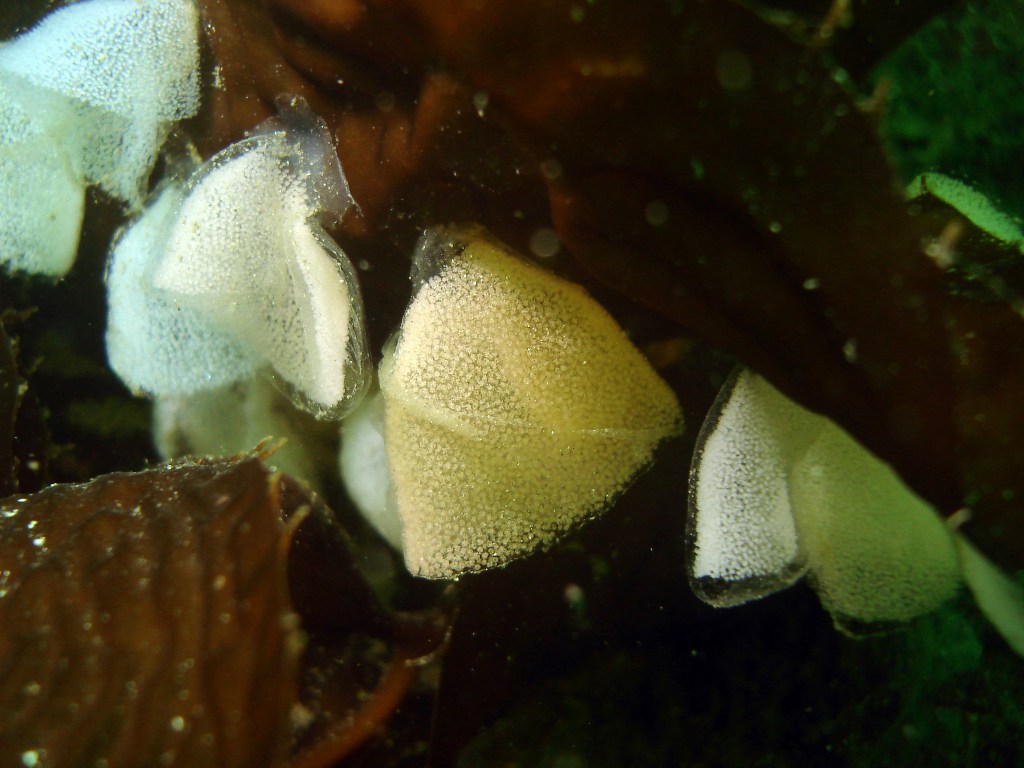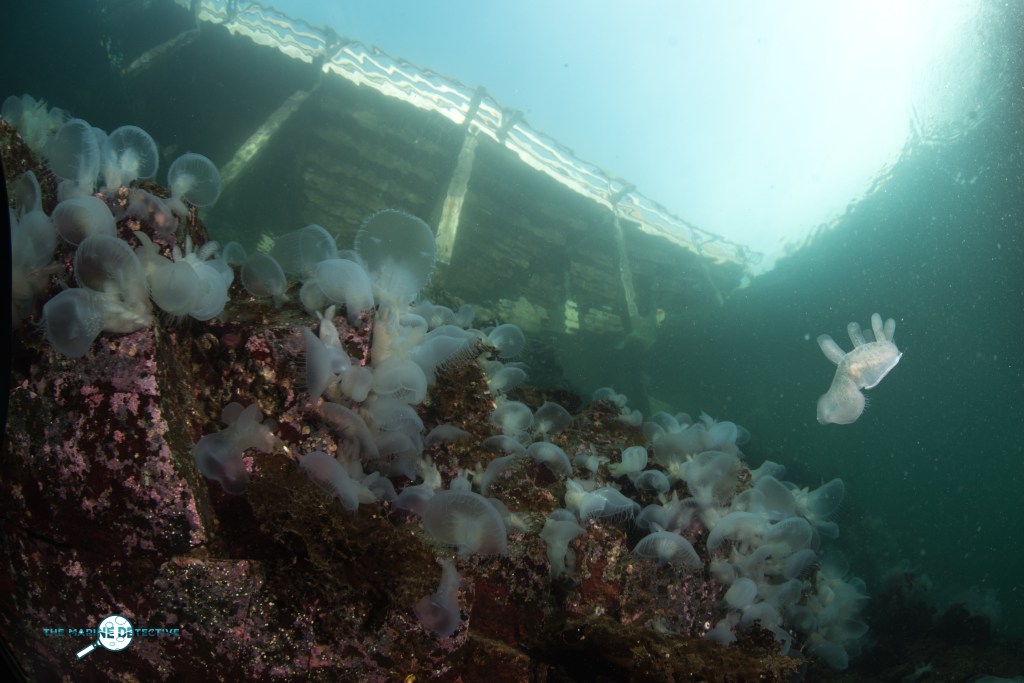Hooded Nudibranchs and their eggs
[Last updated on January 2, 2022]
The remarkable-looking animals to the right are Hooded Nudibranchs (Melibe leonina up to 17.5 cm). A nudibranch is subgrouping of sea slugs whose characteristics include having naked (“nudi”) gills (“branchs”).
Typically, starting in the fall, around northeast Vancouver Island, Hooded Nudibranchs come together in the hundreds. It is awe-inspiring to see them clustered together just below the surface, delicate and ghost-like, clinging to kelp. Most are translucent white but some individuals are more green or orange.
Often, you can see them swimming on the surface and many people mistake them for jellyfish. But no, they are sea slugs.

The large oral hood (disc-like head) is used to feed on plankton and small crustaceans. The lobed structures on the animals’ backs are the naked gills (cerata). The cerata can pop off if the Hooded Nudibranch is threatened e.g. pinched by a crab. This “ceretal autonomy” and the ability to swim, are believed to be distractors for predator (Bickell-Page, 1989).
The two structures on the Hooded Nudibranch’s oral hood are their rhinophores by which they smell their way around. Hooded Nudibranchs are believed to signal one another by emitting a fruity scent. My personal experience after having picked up a dead Hooded Nudibranch on the beach, is that the smell is something like a mix of watermelon and grapefruit. The scent stayed on my hand for more than an hour.

The secretion is reported to serve as a repellent for predators but does not deter Northern Kelp Crabs.
After mating, as is the way with sea slugs, both individuals lay eggs and then, they die. You can find additional information about sea slugs being reciprocal hermaphrodites in this past blog posting.

In the area around northeast Vancouver Island, I have observed that they lay their egg masses between January and April. Each ribbon of eggs is only about one centimetre wide. Every dot is an egg capsule containing 15 to 25 eggs. After about 10 days, depending on temperature, the eggs will hatch into larvae that will be part of the zooplankton soup of the Ocean.
After 1 to 2 months, they settle to the ocean bottom and change body shape and even digestive tract to become small adult Hooded Nudibranchs
Hooded Nudibranchs do not have the rasping mouth structure of many other sea slugs (the radula). They feed by opening their oral hood to capture prey while standing on kelp or Eelgrass.

From Invertebrates of the Salish Sea: ” . . . diet includes copepods, amphipods, and ostracods, as well as small post-larval mollusks. The animal stands attached to the substrate and expands the oral hood. It then sweeps the hood left and right or downward. When the ventral surface of the hood contacts a small animal the hood rapidly closes and the fringing tentacles overlap, holding the prey in. The whole animal is then forced into the nudibranch’s mouth.”

For more information:
Biodiversity of the Central Coast: Hooded Nudibranch
Deep Sea News: “This sea slug is like a cross between a dinosaur, a jellyfish, and a watermelon”
Lawrence, K. A. and Winsor H Watson. “Earth , Oceans , and Space ( EOS ) 10-1-2002 Swimming Behavior of the Nudibranch Melibe leonina.” (2017).
Newcomb, James M., et al. “Homology and Homoplasy of Swimming Behaviors and Neural Circuits in the Nudipleura (Mollusca, Gastropoda, Opisthobranchia).” Proceedings of the National Academy of Sciences of the United States of America, vol. 109, National Academy of Sciences, 2012, pp. 10669–76, http://www.jstor.org/stable/41601654.



10 Responses to “Hooded Nudibranchs and their eggs”
fantastic photographs I love nudibranchs
I love people who love nudibranchs! One of the mysteries on which I spend the most of my time is trying to match nudibranchs with their eggs. Took me several years to know for sure these were the eggs of the hooded. Lots more nudibranch love to come on this blog!
so gorgeous Jackie… can’t wait for more!
My wonderful dive buddy – so many of these shots/opportunities are possible because of our diving together and sharing the passion for it all.
Hey jackie!
The pictures and videos of nudibranches!
So great to know you like nudibranchs!!! If everyone knew about them and cared, I think the world would be a better place!
That is so neat! I was actually really amazed and shocked to hear that they produce phereomones that actually smell like fruit. Very remarkable!
– Just a side thought, I wonder if there are any studies out there that have determined how similar in composition the phereomones of the hooded nudibranchs actually is to the compounds that are produced by plants in their fruits, would be interesting to find out!
Thank you for sharing your knowledge Jackie & your beautiful pictures! I look forward to each new entry you add to your site!
Picked up a hooded nudibranch from a beach on Flores Island today and put him in a safe spot in the water. He was alive and swam off – I found my hand smelt like a mix of fruit and pine, and now, nearly 2 hours later, smells like watermelon! Very interesting!
Thank you so much for this Marcie! Love your very accurate description of the smell as “a mix of fruit and pine”. It is just astounding isn’t it how long the smell persists? Don’t think anyone is quite the same after having smelled the pheromones of hooded nudibranchs – stirs such a sense of awe.